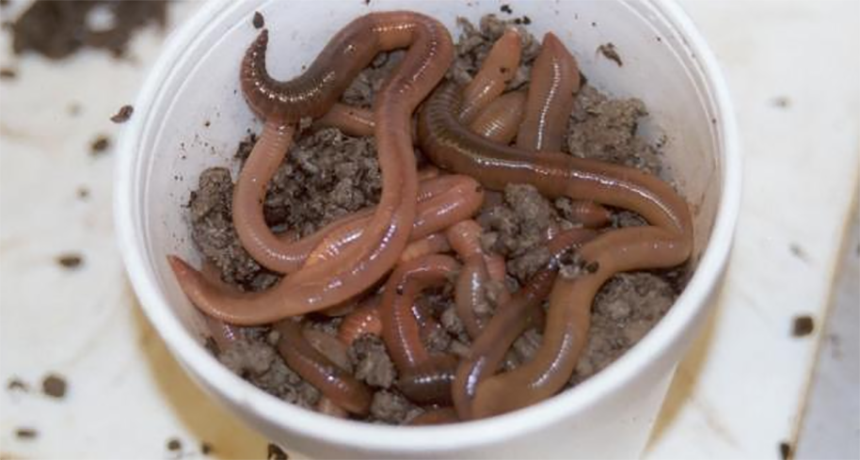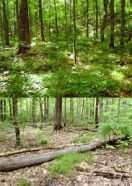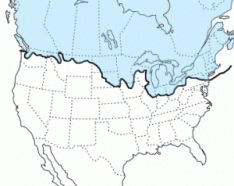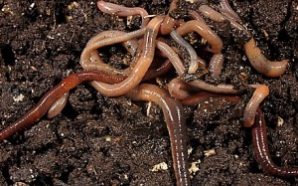Tiny earthworms’ big impact
Invasive earthworms change North American landscapes, for better or worse

Invasive earthworms, like the ones in this bait cup sold at stores, are spread by human activity such as fishermen dumping live bait and gardeners using live compost worms near forests.
UMD-NRRI
Earthworms have many fans. In 1881, Charles Darwin — the father of evolutionary theory — wrote a whole book on earthworms. In it, he concluded that “It may be doubted whether there are many other animals which have played so important a part in the history of the world, as have these lowly organized creatures.”
Gardeners tend to like earthworms because they mix the soil, loosening it and moving nutrients around. Earthworms even shred leftover plant parts into smaller fragments eaten by microorganisms. In these ways, earthworms can improve and enrich the soil, allowing garden and certain crop plants to grow better.
But many American scientists are coming to view some earthworms as enemies.
In the 1600s, European settlers brought European earthworms to North America. At that time, the continent’s northern forests had no soil-mixing earthworms. If any had once existed there, they were likely very different from the European species. And they would have been wiped out during the glacial period that ended 11,000 years ago.
Today, in these forests, legions of earthworms blend soil with plant scraps like fallen leaves and twigs. And that mixing has proven disastrous for the complex network of soil, water, plants and animals — the ecosystem — that developed over thousands of years without earthworms. Since arriving in North America, invasive earthworms have changed the landscape, assisted other non-native species with getting a foothold, and competed with native species.
Great Lakes Worm Watch, which educates the public about the problems caused by earthworms, has recently gone so far as to issue what is effectively a “most wanted” poster for the earthworms. A fact sheet put out by the group proclaims: “Contain those Crawlers.”
Indeed, plead managers of hardwood forests in the northern and northeastern United States: Keep earthworms out of our woods.
The dirt on earthworms
The lowly earthworm is nothing short of amazing. “It is a very simple organism,” explains Mac Callaham, a research ecologist with the U.S. Forest Service in Athens, Ga. And yet, he adds, earthworms have diversified and evolved, or changed over long periods of time. They live in nearly every available habitat, spread across every continent except Antarctica. They live high in trees, 10 meters below the soil’s surface and everywhere in between.
Altogether, scientists have discovered at least 5,000 species and suspect that many more await discovery.

Though native earthworms most likely were wiped out in northern North America when glaciers covered the area, other parts of the continent are rich in earthworm species. “We suspect that there are dozens and dozens, if not hundreds, of undiscovered species,” said Callaham, in addition to the roughly 250 native earthworm species that have been catalogued.
Earthworm species dwell in different habitats and impact their ecosystems in different ways.
All kinds of earthworms fall into one of three main ecological groups. There are earthworms that don’t live in the soil. Instead, they live just above it, squirming in or just below the plant litter — all of the leaves, twigs and bark that have fallen to the ground. These earthworms feed on leaves and on the fungi and bacteria that help break down leaves. Some of these earthworms live even higher up, in trees, inside decaying wood or piles of plant material that gather between limbs.
Then there are earthworms that travel through the upper layers of the soil. Common in gardens, these species feed on leaves, fungi and tiny creatures in that soil layer.
Finally, there are earthworms that burrow deeply into the soil, creating permanent channels up to several meters long. Periodically, they surface for a carryout meal of leaf litter that they’ll carry back down to eat deep in their burrows.
Killer earthworms
Cindy Hale is a research biologist with the Natural Resources Research Institute at the University of Minnesota in Duluth. As a graduate student in the 1990s, Hale took a field trip to Chippewa National Forest in the middle of northern Minnesota. There she saw a changed landscape. Gone were forest floor plants like ferns and wildflowers and understory plants like bushes and tree saplings that make up the middle height of the forest. She and other ecologists on the field trip were given a surprising reason for the loss of the plants and the ecosystem they sustained: invasive earthworms.
To get an idea of the earthworms’ destruction, picture these forests before European settlers — and their earthworms — arrived in the Great Lakes region around 200 years ago. Leaves, twigs and other plant debris had accumulated on the forest floor over the years and created a thick layer of what is called duff. Fungi, bacteria and microscopic invertebrates such as mites slowly broke down this debris. The duff held moisture like a sponge, nurturing the growth of many understory plants like wildflowers, shrubs and tree seedlings. Small animals and birds nested and fed on the forest floor and in understory foliage.
When the first European earthworms arrived, they began doing what they always do: munching, mixing and moving. Some plant litter earthworms munched through the forest floor and its fungi and bacteria. Burrowing species, like the common nightcrawler, pulled leaf litter down into their holes to finish munching and mixing. Slowly, earthworms destroyed the duff on which wildflowers, understory shrubs and tree seedlings depended.
Listing the effects of invasive earthworms on northern hardwood forests is overwhelming.

Before long, says Lee Frelich of the University of Minnesota’s Center for Forest Ecology, “Earthworms become the dominant living thing that influences the ecosystem. They influence the type of plants that can grow, the type of insects that can live there, the habitat for wildlife species and the structure of the soil.”
In one recent study, scientists looked at how invasive earthworms have affected a type of litter-dwelling mite. Mites help break down a forest floor’s duff and spread fungus spores, the tiny reproductive units similar to seeds that give rise to more fungi. Today, more than 100,000 mites of more than 100 species may occupy each square meter of northern forest soil. That may sound like a lot, but this study showed that in soil free of invasive earthworms, the mites seem to fare better. They were between 72 and 1,210 times more abundant and the number of mite species was one to two times higher.
The potential reasons for this difference reveal a complex soil ecosystem. The earthworms’ soil mixing might be eliminating the fungi on which mites feed, or the earthworms might be introducing additional routes — earthworm tunnels — through which other predators could enter the soil and eat the mites.
Jumping earthworms
“Even if the European earthworms don’t scare you, the Asian ones should,” said Hale. These earthworms are more aggressive, faster-moving and more damaging.

These Amynthas species are among the most reviled earthworms in America. Called “jumpers,” they can thrash, whip around and jump, clearing a few inches at a time. Introduced from Asia, these earthworms became established in parts of the United States by the late 1800s. Composters and fishermen use and sell them.
While scientists and land managers all acknowledge that European earthworms have some positive features, especially in agriculture, experts don’t want to have anything to do with Amynthas types.
In and around Tennessee’s and North Carolina’s Great Smoky Mountains National Park, “We are most concerned about the Amynthas species,” says Callaham. European earthworms also live in the area, along with native earthworms. But the European species appear to do best in disturbed sites — places where humans have already been moving plants and soil around. This includes agricultural areas, where the European worms are valued. Amynthas earthworms, by contrast, seem to thrive everywhere.
A 2010 study by Bruce Snyder of Kansas State University in Manhattan looked at native millipedes and Amynthas agrestis in Great Smoky Mountain National Park. Snyder’s work is among the first to look at how jumping Asian earthworms interact with a native species.
Both millipedes and Amynthas agrestis live and eat in plant litter, so they potentially compete for food. Researchers counted how many of each was present in tiny plots of ground. In plots with Amynthas agrestis, the number of millipede species was reduced by 63 percent and the total number of millipedes was reduced by 30 percent, compared to plots where there were no jumpers. Snyder hopes to further investigate why the arrival of Amynthas leads to fewer millipedes.
Humans and earthworms
Earthworms don’t move fast. The leading edge of an earthworm invasion can advance, on average, 10 meters per year. But humans can accelerate the worms’ spread.
Fishermen often use invasive earthworms for bait. Many have introduced invasive earthworms to rivers, streams and lakes previously unexposed to these animals. Gardeners who use earthworms to create rich compost for their soil may unwittingly introduce invasive ones. The worms and their tiny cocoons (from which hatchlings will emerge) even hitch rides in the mud on tires, potted plants and road materials shipped around the nation.
“They move around as fast as people move them,” said Minnesota’s Frelich. Thanks to people and their activities, invasive earthworms have now spread throughout the United States and other parts of the world.
But they’re not everywhere yet. In the Great Lakes region, “20 percent of the landscape is earthworm-free,” says Hale. Of the remaining 80 percent of land, half of the terrain has fewer than two earthworm species — meaning there isn’t yet too much impact on the ecosystem, she explains. For these regions, she says, now is the time to take action.
Educating the public, especially fishermen and composters, is one approach to stopping the spread of invasive earthworms. Identifying which lands are currently earthworm-free is another.
Ryan Hueffmeier is program coordinator for Great Lakes Worm Watch. Along with Hale, he has been working on a research-based model that will help create large maps of areas with minimal or no damage from invasive earthworms. Ultimately, landowners can use the model to identify earthworm activity on their property. Once identified, lands with minimal or no earthworm damage can be targeted for protection.
But scientists suspect that once invasive earthworms arrive they can’t be removed. And even if all could be, affected forests might never return to the way they were. “It’s very much a story of learning to live with them,” concludes Frelich. If invasive earthworms impact native plants, he says, forest managers may have to learn how to counter the disruptions.
Forest ecologists have called earthworms “ecosystem engineers” because they can modify or create habitats that otherwise would not be present. Whether this is a good thing depends on the situation.
“Earthworms aren’t good or bad,” said Hale. “What they do and how we value it is what matters. In one place — farm fields or gardens — we really like European earthworms and what they do, so we consider them good. In native hardwood forests, we really don’t like what they do — so we consider them bad. You really have to understand how an organism affects an ecosystem,” she explains. “Things aren’t black and white.”
Power Words
Evolve To change, especially from a lower, simpler state to a higher, more complex state, over a period of time.
Ecosystem A group of interacting living organisms — fungi, plants, animals — and their physical environment — water, soil, rocks.
Microscopic A very small living or nonliving object that cannot be seen without a microscope.
Invasive A non-native species whose arrival can cause ecological and economic damage.
Understory Plants that grow below the canopy (tallest level) of the forest.
Invertebrate Animals without a backbone. Earthworms, mites and millipedes are all invertebrates.
Hardwood forest An ecosystem with mostly deciduous trees, which lose their leaves. These are in contrast to pine and other evergreen trees.
Species A group of similar organisms capable of interbreeding.
Millipede Long-bodied invertebrates with many segments. Most body segments have two pairs of legs.
Compost The end product in the breakdown, or decomposition, of leaves, plants, vegetables, manure and other once-living material. Compost is used to enrich garden soil, and earthworms sometimes aid this process.
Model A simulation of a real-world event that’s developed to predict an outcome.







